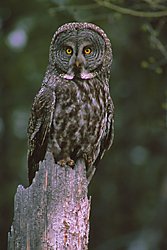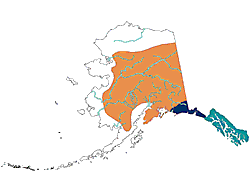Great Gray Owl
Strix nebulosa

Characteristics:
At 24-33” long, the Great Gray Owl appears to be the largest owl in Alaska, although both the Great Horned and Snowy Owls are heavier and stronger. The Great Gray has a very large head (making its yellow eyes appear small), a heavily ringed facial disk with concentric gray circles, an overall dusky gray appearance with streaked underparts, and a relatively long tail. It lacks the ear tufts of the Great Horned Owl.
Hunting Techniques and Prey:
Sensitive hearing allows Great Gray Owls to detect voles moving under the snow. They often plunge-dive into the snow in pursuit of prey, and can capture voles tunneling a foot beneath the surface. Yellow-cheeked voles, meadow voles and red-backed voles are the Great Gray’s main prey and it usually hunts them at dusk or at night.
Habitat:
Boreal forest and wooded bogs are where Great Gray Owls are found. They hunt along forest edges and in small openings in the forest such as old river sloughs, old burns and open stands of tamarack. They usually nest in a large, broken birch, spruce or poplar tree trunk.
Voice:
Great Gray Owls give a monotonous series of deep, low-pitched single or double-syllabled hoots. Calling begins in January or February, but peaks during March through May. Occasionally they hoot during midsummer and autumn.

|
|
|
|
Common Uncommon Rare |
 This information is from The Alaska Owlmanac: A guide to the identification, habits, and habitat of ten owl species found in Alaska.
The Alaska Owlmanac (PDF 1,163 kB)
This information is from The Alaska Owlmanac: A guide to the identification, habits, and habitat of ten owl species found in Alaska.
The Alaska Owlmanac (PDF 1,163 kB)
